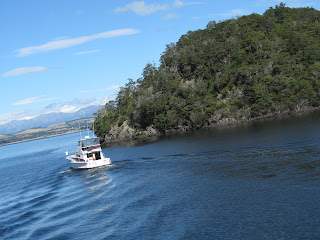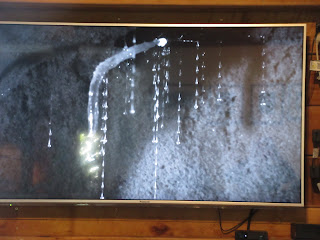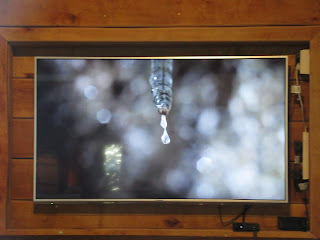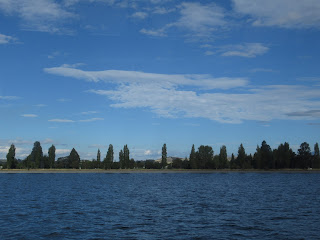I am simultaneously finishing a travel blog about the fantastic 4.5 month long trip Steven and I took last fall to Armenia, Georgia, Azerbaijan, much of Central Asia and then the final six weeks in Spain and Portugal. If you're interested in checking that exciting adventure out, here's the link:
www.bergersadventures6.blogspot.com
www.bergersadventures6.blogspot.com
That morning Diane and I spent a few hours in Queenstown at the city's gardens and going for a walk across the historic Shotover Bridge before driving through endlessly peaceful rolling hills and pastures filled with sheep toward the small town of Te Anau in the Fiordland area of New Zealand's South Island. On arrival, we almost immediately signed up for a fun, if pricey, scenic cruise across Lake Te Anau as that was the only way of accessing the Glowworm Caves on the other side of the lake.
There were just 36 people on the 78-capacity boat that took us across the largest container of water by volume in Australasia and, at almost 1400 feet, the third deepest lake in New Zealand.
Long ago Te Horo discovered a magic spring with pure water and many fish. After reminding his wife to keep the spring's secret to herself, Te Horo left to begin a long journey. After many days apart, Te Horo's wife took a lover and led him to the secret waters. At the same moment her lover's face was mirrored in the pool, the waters at the spring flowed forth and created the lake now called Te Anau.
The guide on board pointed toward the three large fiords off the lake.

He talked about the the 62-kilometer-long Kepler Track that was the tracking (or trekking as we would call it in North America) capital of the country. He joked that if the three to four day hike were too long, the town of Te Anau hosts a running race each December. Three years ago, the time was set by an Aussie at just 4 hours and 32 minutes! If that sounded too intense, the Luxmore Grunt might be a better option as that was only 27 kilometers and would take just two to three hours. That was such a popular hike that spots sell out in just five minutes every year, he said!
What we were looking at, according to the guide, were virgin forests with all native animals which meant birds only. There were two native mammals, both bats, including a short-tailed bat that has been rediscovered in the mountains here. He, like our guide Wolfy on our tour of Skippers Canyon the morning before, also talked about the devastation caused by possums that had been introduced from Australia. It had no predators except for car tires so he suggested we all do our part and do away with as many possums or 'speed bumps' as we could while driving! I cringe when I think what animal rights activists would have to say about that.
It was a wonderful day to be on the lake as it was mostly sunny and smooth. The catamaran seemed to fly across the lake making a detour around the scenic Dome Islands.

I was spellbound by the beauty of the day and the view of the sheer mountain faces rising out of the water. I could certainly understand why UNESCO had declared the area a World Heritage Site.
In the distance, a controlled burn was taking place which caused the hazy skies in one direction only.
Because the catamaran was going at a good clip, it was extremely windy up top but I enjoyed the views and the feel of the wind against my skin so much more than being down below.
We reached the other side of the lake a short thirty minutes after leaving the town.
From the dock there was just a short walk to Cavern House where we were introduced to the world of glowworms.
In the Cavern House, we learned that an adult fly lays approximately 130 tiny sticky eggs onto the ceilings of caves in clusters of 40 or 50. They hatch about three weeks later. Hatching occurs in all seasons but most commonly in December but it wasn't explained why then particularly.
At nine months, the eggs hatch into larva - i.e. the glowworm and immediately start building individual nests with 'fishing lines' to catch food. We learned that a glowworm was from two-four centimeters in size, i.e. about the size of a matchstick. Each glowworm has an organ in its tail that produces the light to attract food. It takes about half an hour for a glowworm to make each line to attract food such as sand flies. This is where the 'glowing' part comes from. Glowworms only feed when they are in the larva state and not in other parts of their life cycle.
About 12-14 days when the glowworms get to a certain size and body weight, they cover themselves in a protective skin and become a pupa. The larva removes some of its feeding lines leaving an encircling barrier of shorter protecting lines. In the pupa stage, the sexes become apparent with the female being about 10-15% larger.
A glowworm reels in the line with a moth on the end and eats it through the eyes! I never knew glowworms were territorial animals that they eat each other over territory as well as when they're bored or there isn't enough food! The latter made sense as a glowworm's sole purpose is to eat.

The glowworm caves were close to the shoreline so the path from the Cavern House to the opening of the cave was just a brief walk through a magnificent beech forest before the path descended between the rocks and into the cave mouth which was covered in rich moss.

Luckily Diane and I remembered that the red light in the cave meant not to stand up shortly after entering the cave because of the very low overhang! The guide on the boat had jokingly said the entrance had been made for hobbits as it was only 1.3 meters high!
One person described the scene as "a river of light that painted the roof with moving ripples and waves." Once inside the caves, we could view the still developing cave formations due to the rushing water. We drifted through caverns inhabited by glowworms.
For many years the Te Anau caves were lost in legend and their presence were only hinted at in ancient Maori names. Te Anau translated as 'caves with a current of swirling water.' They remained hidden until their rediscovery by explorer Lawson Burrows in 1948.
The Te Anau Glowworm Caves, unique to the Southern Hemisphere, were still geologically active which meant water that was rushing through the caves still shaped and formed the surrounding rock.
It took a while to adjust to the darkness of the subterranean world. The Maori name for a glowworm, Titiwai, captured the astonishing beauty of 'lights reflected in the water.'
Steven: I remember thinking Diane and I couldn't even see our feet and had to feel our way along via handrails as there were so few lights. It was a VERY different experience from any US or foreign caves we've been to in that way. Again very unlike other caves, there was constantly rushing water and waterfalls in the cave which made a tremendous racket almost the entire time.
The path wound through the cave and up the waterfalls. At the top of a large waterfall, I could see the water plummeting over the edge through the grating below my feet. A boat appeared out of the inky blackness and we climbed aboard. Immediately, all the lights were turned off and we were suddenly in pitch black with the only sound the roar of the waterfall.
It was so disorienting being in total darkness that I imagined it being like we suddenly struck blind. I could well imagine how panicky some people could get in the caves with the very low ceilings, the fact we couldn't see our feet at all and that we were walking blind a good part of the time in the cave. It definitely wasn't the first time there was a very different perception of safety we'd noticed while traveling in New Zealand.
It was so disorienting being in total darkness that I imagined it being like we suddenly struck blind. I could well imagine how panicky some people could get in the caves with the very low ceilings, the fact we couldn't see our feet at all and that we were walking blind a good part of the time in the cave. It definitely wasn't the first time there was a very different perception of safety we'd noticed while traveling in New Zealand.
It was very neat seeing glowworms but NO photos were allowed of them - drat! I did manage to take some photos in the cave which, although it was also verboten, I hung back to do so. The Te Anau Glowworm Caves were part of the much larger Aurora Caves which are 12 kilometers long that had been discovered 400 years ago by the Maori.

Our journey through the cave only lasted about forty-five minutes or so including the pitch black boat ride. The cave only closes when then has been so much rain raises the water level too high. The tour ended with a interesting walk back to the dock through a rainforest filled with a huge variety of ferns.
Despite being a tropical group of plants, New Zealand had an unusually high number of fern species for a temperature country. Their approximate 200 species range from 10 meter high tree ferns to filmy ferns just 20 millimeters long. About 40% of the fern species occur nowhere else in the world.

The ride back across the lake was just as enjoyable as the ride over had been. Plus, I really liked being able to see it from different views.
Diane and I both had a hoot posing for photos by the cute bench in front of our motel that night before getting an early night's sleep as we had to get up well before dawn for the long drive to Milford Sound.
Next post: Driving before dawn to Milford Sound for a cruise and then retracing our steps all the way back to Queenstown and then north to Wanaka.
Posted on April 12th, 2019, from Littleton, Colorado.
Posted on April 12th, 2019, from Littleton, Colorado.








































WOW, that trip looked like a lot of fun. "Shine little glow worm, glimmer, glimmer. Shine little glow worm, glimmer, glimmer. Lead us lest too far we wander....." from a song from Paul Lincke's 1902 operetta Lysistrata. Boy, did I drag that one up from the past... Janina
ReplyDeleteJanina,
ReplyDeleteNever heard that cute little ditty before but Steven said he did. He mentioned it may have been only known here in the US and not in my native Canada.